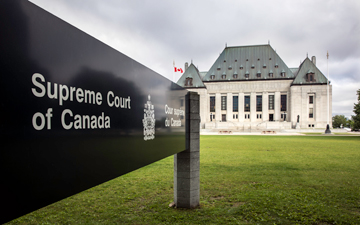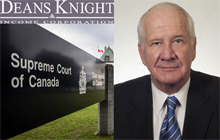Deans Knight will have a serious impact on tax planning & tax disputes

The courts will increasingly gravitate toward the minority approach in the Deans Knight decision, assert the tax lawyers of Counter Tax Litigators
 |
Peter Aprile is the founder of and a partner, specializing in tax dispute resolution and litigation, at Counter Tax Litigators. |
SECTION 111 of the Income Tax Act ("ITA") allows taxpayers to carry losses back and forward to offset income in different taxation years. However, subsection 111(5) restricts non-capital loss carryovers for a corporation if there is a change in control, and the new owners do not continue the same or similar business that incurred the losses.
In Deans Knight Income Corp. v. Canada,[1] the Supreme Court of Canada held the general anti-avoidance rule ("GAAR") restricts a corporation's ability to deduct non-capital losses when de jure control has not changed and the corporation earns income from a new business activity.
While we recognize the validity of certain aspects of the majority's stance, we argue that they failed to properly manage the provision's and the GAAR's clarity and flexibility. The majority's ruling in Deans Knight creates an imbalance and instability in our tax system.
The majority's GAAR approach in Deans Knight over-emphasizes flexibility. The majority's approach appears to lack restraint. And the majority's conclusion alleviates Parliament from its responsibility to create legislation with the degree of clarity necessary for a fair tax system. In the near term, Deans Knight will unsettle tax planning and tax controversy in Canada. It will increase uncertainty in GAAR disputes, making it harder for taxpayers to assess risks and anticipate outcomes.
Deans Knight is likely to encourage the Canada Revenue Agency to try to expand its GAAR reach and efforts to extract tax revenue from private businesses and other value-generating taxpayers in manners that, in our view, don't align with the SCC's prior decisions and accepted legal standards.
While we anticipate a series of challenging GAAR disputes in the coming years, the minority's approach in Deans Knight stirs optimism in the long term. If courts adopt and apply Justice Côté's GAAR approach skillfully, we will move more quickly towards a better-balanced tax system and a thriving Canada.
Deans Knight is likely to encourage the Canada Revenue Agency to try to expand its GAAR reach and efforts to extract tax revenue from private businesses and other value-generating taxpayers in manners that, in our view, don't align with the SCC's prior decisions and accepted legal standards.
Facts in Deans Knight
Deans Knight operated a drug research and nutritional food additives business. At the time, Deans Knight operated under Forbes Medi-Tech Inc. ("Forbes"). Forbes was not financially successful and accumulated $90 million in non-capital losses. Without income to apply the losses, Forbes sought to use the losses to create value in another way.
Matco Capital Ltd. ("Matco") operated a private investment holding company. Forbes partnered with Matco to create value from the losses. The parties understood that if Matco or any other party acquired de jure control of Forbes, the CRA would reassess to deny the claimed losses under subsection 111(5) of the ITA. So, the parties designed and structured a plan to sidestep a change in de jure control and subsection 111(5).
In 2008, Forbes and Matco entered into an agreement. In line with the parties' strategy and agreement:
- Forbes transferred its assets to a newly incorporated parent company ("NewCo"), and NewCo assumed Forbes's liabilities.
- Forbes issued, and Matco purchased, a $3 million convertible debenture that Matco could convert into a minority percentage (35%) of NewCo's voting and non-voting shares.
- NewCo agreed to avoid any action that might cause a change in control without Matco's consent.
- Matco searched for a business and opportunity to enable NewCo to use the losses to offset income from new business.
- Matco found an opportunity with Deans Knight Capital Management, a mutual fund management company. They struck a deal to use Forbes for an initial public offering to raise funds and invest in high-yield debt instruments.
- Forbes changed its name to Deans Knight.
- Deans Knight deducted the losses against the portfolio income it earned in its 2009 to 2012 taxation years.
The CRA denied the deductions. Deans Knight objected to the reassessment and appealed to the Tax Court. The Minister adopted the position the GAAR applied to deny the deductions because the transactions led to a tax benefit, were avoidance transactions, and were abusive. The Tax Court held the tax avoidance transactions were not abusive and allowed Deans Knight's appeal. The Minister appealed to the Federal Court of Appeal. The FCA held the transactions were abusive, denied the tax benefits, and upheld the CRA's reassessments. Deans Knight appealed the FCA's decision to the Supreme Court of Canada.
The Majority's View
The SCC's majority in Deans Knight held that the transactions were abusive, and the GAAR applied to deny the tax benefits.
The majority explored the object, spirit, and purpose ("OSP") of subsection 111(5) of the ITA to determine whether Deans Knight's avoidance transactions constituted an abuse. The OSP represents Parliament's rationale that underlies the provision. The majority contemplated: What was the result or mischief that Parliament sought to prevent?
The majority's first step in determining Parliament's rationale was to separate the rationale from the means (or strategy) Parliament used to try to achieve its purpose (i.e., the provision itself).
[I]t is critical to distinguish the rationale behind a provision from the means chosen to give that rationale effect within the provision. The drafting process reflects the task of translating government aims into legislative form in order to create intelligible, legally effective rules ... However, the means do not necessarily provide a full answer as to why the provision was. This is not to imply that Parliament cannot translate its aims into effective legislation— quite the opposite: when drafting legal tests, Parliament is seeking to establish a general standard that is most faithful to its objectives from the options which are available and practicable.[2] [bold added]
The majority outlined their approach, looking into internal and external factors, including the provision's text and context. They then used this rationale to evaluate if the transactions contradicted or circumvented it. If transactions sidestep a provision's rationale, the majority would conclude the transactions were an abuse of the ITA, justifying the denial of associated tax benefits.
Parliament's Rationale: The Majority's View
As stated, section 111 allows taxpayers who suffer losses to deduct the losses. Subsection 111(5) gives corporations the same benefit unless a new shareholder base engages in a new different business activity. The majority recognized that Parliament chose de jure control as the test when applying subsection 111(5). However, the majority held that other provisions in the ITA "suggest that de jure control is not a perfect reflection or complete explanation of the mischief that Parliament sought to address"[3] and Parliament intended to preserve a link in continuity in subsection 111(5) between new owners, the business, and the losses.
This perspective led the majority to believe that Parliament's subsection 111(5) rationale was to "ensure that a lack of continuity in a corporation's identity was accompanied by a corresponding break in its ability to carry over non-capital losses".[4]
In Deans Knight, the transactions did not contradict the explicit wording of the provision, but they did run counter to the majority's interpretation of Parliament's rationale for the provision. The majority asserted that Deans Knight's actions effectively achieved an outcome Parliament actively tried to prevent. Based on this determination, the majority concluded the transactions were abusive avoidance transactions, triggering the application of the GAAR to disallow Deans Knight's non-capital losses.
The Dissent's View
The dissent held Deans Knight's avoidance transactions did not contravene Parliament's rationale and, therefore, were not abusive avoidance transactions.
Parliament's Subsection 111(5) Rationale: The Dissent's View
For Justice Côté, "[t]he key question [was] whether Parliament intended to prevent or permit a certain type of transaction".[5] However, the process of determining intent is inherently fraught with ambiguity. Faced with this inherent uncertainty, Justice Côté relied on the GAAR caselaw to guide her OSP analysis and dynamically steer toward her impression of Parliament's rationale.
In particular, Justice Côté relied on the SCC's decisions in Canada Trustco, Copthorne, Landrus, Alta Energy, and Lipson to hold herself accountable and self-assess her understanding of Parliament's intent in this case.
- Justice Côté cited Canada Trustco for the principle that "the GAAR does not and cannot override Parliament's specific intent regarding particular provisions of the Act".[6] We interpret this to mean that if a decision-maker's understanding of Parliament's intent conflicts with its policy directives, then the decision-maker's OSP analysis is flawed. We agree with Justice Côté's view.
- Justice Côté referred to Copthorne to underscore the principle that decision-makers should not interpret and apply the GAAR based on their moral judgment of a taxpayer's actions and "a provision's text can sometimes be conclusive because it is 'consistent with and fully explains [the provision's] underlying rationale"'.[7] [emphasis added]
- Justice Côté cited Landrus to highlight that "where it can be shown that an anti-avoidance provision has been carefully crafted to include some situations and exclude others, it is reasonable to infer that Parliament chose to limit their scope accordingly".[8][emphasis added]
- Justice Côté repeated Justice Binne's warning in Lipson that "[t]he GAAR is a weapon that, unless contained by the jurisprudence, could have a widespread, and serious unpredictable effect on legitimate tax planning".[9][emphasis added]
Guided by these principles, Justice Côté explored subsection 111(5)'s underlying rationale.
Subsection 111(5) and De Jure Control
As noted earlier, Justice Côté's central focus revolved around discerning Parliament's intent: Did Parliament aim to allow or prohibit this specific type of transaction under subsection 111(5)?
Justice Côté noted that Parliament intended de jure control to constitute an essential element of subsection 111(5)'s object, spirit, and purpose. The majority acknowledged this point in their reasons too. Justice Côté stated that a corporation's constating documents (e.g., articles of information, shareholder agreements, by-laws) grant or limit the rights that create de jure control.
The transactions in Deans Knight did not change the corporation's constating documents. Since the transactions did not change shareholders' rights, Justice Côté believed that de jure control did not change. This key point is where the majority's and dissent's opinions diverge. Justice Côté held the transactions did not contravene Parliament's intent for subsection 111(5), did not constitute abusive tax avoidance, and should not trigger the GAAR.
The transactions in Deans Knight did not change the corporation's constating documents. Since the transactions did not change shareholders' rights, Justice Côté believed that de jure control did not change. This key point is where the majority's and dissent's opinions diverge.
In Our View
The tax community has already published several articles summarizing the SCC's decision in Deans Knight. A few authors and experts have shared their views on the SCC's ruling.
BLG's team authored insightful articles discussing Deans Knight and the GAAR amendments. Also, Allan Lanthier's perspective on Deans Knight deserves consideration. Allan describes Deans Knight as a "breath of fresh air" and believes it establishes a better equilibrium between taxpayers' right to plan their finances and the government's responsibility to protect the integrity of the income tax system.
We do not share the belief that the majority in Deans Knight updated the GAAR framework. Instead, we think the majority restated or clarified the GAAR framework. The majority rightly warned against an excessive textual analysis and approach. We agree with this view and consider it sensible and in line with the GAAR caselaw.
We share the majority's view that a GAAR analysis that excessively emphasizes the text and demands absolute clarity results in excessive rigidity. This approach overlooks Parliament's intended objectives and rationale, leading to an under-protected tax base. However, a GAAR analysis that overly concentrates on a subjective interpretation of Parliament's reasoning has its own negative consequences. An excessive focus on the Parliament's rationale invites unclear laws and inconsistent outcomes.
We do not think Deans Knight set up a new GAAR framework. We take no issue with the majority's portrayal of the appropriate GAAR balance, in theory. However, we believe the majority misapplied the GAAR to the facts and provision in Deans Knight. In that sense, we believe the majority's decision is incorrect, and we feel very concerned about the broader short-term impact of this decision.
[We] believe the majority's decision is incorrect, and we feel very concerned about the broader short-term impact of this decision.
Clarity & Flexibility > Us v. Them
The majority in the SCC and most tax commentators seem to see Deans Knight as a struggle between the right of taxpayers to reduce their tax burden, as outlined in the Duke of Westminster principle, and the government's duty to safeguard its tax revenue. We believe this framing is unconstructive because it invites polarized standpoints and moral evaluations into the analysis. Instead, we believe it's more effective to approach these matters by framing them as a process of understanding and managing the inherent tension between "clarity and flexibility" within the GAAR.
We imagine the unconstructive "taxpayer versus government" framing might explain why the majority (and some commentators) do not give the appropriate weight to subsection 111(5)'s text and the de jure control caselaw in Deans Knight, favouring an interpretation of the provision's rationale in a way that seems aspirational and out of hand.
And we infer this frame contributed to the majority's decision to introduce the "functionally equivalent" concept. If the majority applied the GAAR to Deans Knight's transactions without these intellectual moves, their analysis and conclusion would have clashed with the GAAR caselaw, making the flaws in their position evident.
When we compare the majority's and dissent's rationale, we imagine the majority followed a predetermined conclusion. A polarized standpoint and a silent moral judgment likely served as the catalysts, leading to the majority's tangled reasoning that went beyond the established caselaw.
In contrast, Justice Côté's analysis stands out for its intelligence, humility, and discipline. She adeptly calibrated the scope of both the provision and the GAAR, demonstrating a responsible approach to navigating a very complex legal path. Her method manages the tension between textual rigidity and subjective interpretation, resulting in a balanced view. Moreover, her reasoning aligns with established legal principles and past decisions from the SCC, adding credibility to her analysis.
The GAAR After Deans Knight
The majority in Deans Knight created much more flexibility in our tax system. As a result, it created much less clarity and more uncertainty and instability for taxpayers in the near term. But, in the long term, we think Justice Côté's approach will quietly take over and create a stronger tax framework.
Short-Term Effects
We anticipate the over-emphasis on flexibility will manifest in three ways in the short term.
First, Deans Knight makes it more difficult for taxpayers to understand and assess their tax planning risks. The CRA is more likely to apply the GAAR expansively. We imagine most tax experts will find it very difficult to reliably anticipate the tax plans or transactions the CRA will target. Adding another layer to this challenging scenario is the CRA's ability to change its mind and contradict its past positions anytime, without adverse consequences.
Second, taxpayers will face more complexity and economic risk. This ruling adds a layer of difficulty to the already challenging task of predicting risks and outcomes. To navigate this level of complexity and risk, taxpayers must hone their 'complexity-navigating' skills and temperament. Also, their tax dispute teams must create more clarity.
Third, Deans Knight will create a series of GAAR disputes, problematic decisions, and appeals. Given the current situation, it is almost certain these disputes will not end at the audit or objection stages, and a Tax Court ruling is unlikely to end significant conflicts. Most important tax disputes will end after a Federal Court of Appeal hearing and decision. This expected litigation journey calls for taxpayers to assemble the right tax dispute team and design and execute the right strategy.[10]
We've read articles suggesting the majority's decision in Deans Knight won't create these negative effects. These authors likely believe the risks we've outlined will not materialize. However, we find no evidence to support this view. Moreover, our 18 years of specialized focus and tax dispute engagement lead us to a different conclusion.
Long-Term Optimism
We believe the Deans Knight disruption will subside in the long term. We feel optimistic because we think that, over the long term, the courts will increasingly gravitate toward Justice Côté's approach. When that happens, the courts will establish a more balanced and reliable tax framework, creating an environment where taxpayers can understand the goalposts and create value.
The Pivotal Question & Right Bias
As we grapple with the post-Deans Knight landscape, it's worth reminding ourselves of our shared goal: building a thriving Canada.
The question is not whether to achieve perfect clarity or flexibility in our tax system; that ideal is unattainable. The real question is which direction to lean toward when working on GAAR legislation and cases.
Should stakeholders lean toward "clarity over flexibility", minimizing taxpayer uncertainty and potentially boosting innovation and investment? Or should stakeholders favour "flexibility over clarity", providing the government more adaptability to obtain and safeguard tax revenue?
We guess the pivotal question for you is: Which GAAR approach will better fulfill our "thriving Canada" shared goal? And please show your work for clarity.
Footnotes
1. Deans Knight Canada Income Corp. v. Canada, 2023 SCC 16.
2. Ibid at 59.
3. Ibid at 95.
4. Ibid at 113.
5. Ibid at 151.
6. Ibid at 146.
7. Ibid at 150.
8. Ibid at 151.
9. Ibid at 143.
10. While this might sound self-serving, we genuinely believe the "right tax dispute team" in these situations include tax lawyers with a practice that focusses exclusively on tax litigation. In some cases, we observe that tax lawyers and accountants don't suggest their clients to invite tax litigation specialists to join the team. They may believe the existing team has the necessary capabilities or that the dispute won't escalate. We consider this approach potentially self-serving on their part and it likely increases the risk a lower quality or wholly unsuccessful outcome. A high-quality and litigation-focused strategy is essential these types of cases from the very beginning, for example, before responding to CRA inquiries or submitting audit materials.
Peter Aprile is a partner and the founder of Counter Tax Litigators ("Counter). Natalie Worsford and James Roberts are partners and Jennifer Mak is an associate at Counter. This article is reprinted with permission of Counter and originally appeared here. Title image: iStock.









(0) Comments